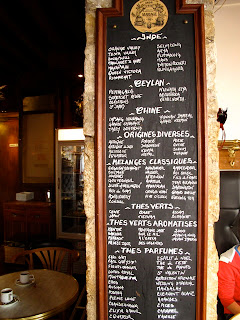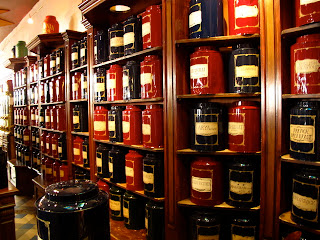We went back to Beaune during Ascension Day weekend, about 2.5 hours away, visiting the cellars of Chateau de Pommard for a wine tasting.

 The old press.
The old press. Our guide, Eric, explained about the ancient dirt giving these old, pinot noir roots a concentrated bouquet, for which the wines of Pommard village and chateau are famous. It is easy to wax poetic, "going Biblical" with grapes turning into wine metaphor: beautiful drink resulting from pruning above and determined digging below of roots
Our guide, Eric, explained about the ancient dirt giving these old, pinot noir roots a concentrated bouquet, for which the wines of Pommard village and chateau are famous. It is easy to wax poetic, "going Biblical" with grapes turning into wine metaphor: beautiful drink resulting from pruning above and determined digging below of roots firmly grounded in soil.
firmly grounded in soil.
Hard to fathom the 31 miles of cellar (caveau) beneath the city of Beaune alone.

Hard to resist ordering delicious entrecote (rib steak) of charolaise cattle. Jack got in on a little wine action.
Jack got in on a little wine action.
 Jack got in on a little wine action.
Jack got in on a little wine action.
 I was startled to learn that one of the Pommard estate owners was Jean Laplanche, famous psychoanalyst whose famous encyclopedia I studied in the heady days of postmodern theory while at Cornell.
I was startled to learn that one of the Pommard estate owners was Jean Laplanche, famous psychoanalyst whose famous encyclopedia I studied in the heady days of postmodern theory while at Cornell.  The chateau had an art gallery of 20th century modern classics: Warhol, Picasso, Leichenstein and Miro, which Michael studied at school this year.
The chateau had an art gallery of 20th century modern classics: Warhol, Picasso, Leichenstein and Miro, which Michael studied at school this year.
***
Beaune is pretty much food & wine, extending into nearby Dijon, where we "trained" in for a cooking class. First coffee & croissant at Comptoir des Colonies, a funky spot near the market featuring blends from the famous Parisian tearoom, Mariage Freres.
But we were for
and some down time before hitting...

the Dijon market

This beauty was designed by Gustav Eiffel and houses the Dijon food market, the outside stalls sell non-food.
Our tour guide and chef was Alex Miles, an American who arrived in 1979, working his way up the master chef ladder and achieving a rare status as accepted foreigner.  Alex explains the stages of cheese one can buy, as the whey separates. A well-informed and connected Frenchman now, Alex is an academic of sorts, lecturing at NYU and corporate circles on the sociology of food. In a space of an hour, he introduced us to a dozen of the best vendors - grow, raise, slaughter all their own vegetables, fowl, etc. as well as a Michelin restaurant inspector.
Alex explains the stages of cheese one can buy, as the whey separates. A well-informed and connected Frenchman now, Alex is an academic of sorts, lecturing at NYU and corporate circles on the sociology of food. In a space of an hour, he introduced us to a dozen of the best vendors - grow, raise, slaughter all their own vegetables, fowl, etc. as well as a Michelin restaurant inspector.
vege starter: homemade pastry dough with celery root, carrot, green bean, mushroom and LOTS of butter.
 Japanese sense of aesthetic refinement and perfection nicely dovetails with the goals of French cuisine. These delights below are from a new pastry chef and his Japanese wife. Those are viles of RUM.
Japanese sense of aesthetic refinement and perfection nicely dovetails with the goals of French cuisine. These delights below are from a new pastry chef and his Japanese wife. Those are viles of RUM. Alex with friend Gilliam, a wry Air France pilot, whose 17th century old town apartment provided the setting.
Alex with friend Gilliam, a wry Air France pilot, whose 17th century old town apartment provided the setting. Michael seemed to enjoy handling the rabbit's organs(!), as well as prep work. Jack and Beth look on.
Michael seemed to enjoy handling the rabbit's organs(!), as well as prep work. Jack and Beth look on.
LOVE THIS LACANCHE STOVE!
My object of desire:
Alex got fancy with cream puff dough, spelling SUGI.
Gilliam's family and arty decor. Wine glass chandelier.
The plant watering can/water vase
 Alex gave us a far more engaged session, culturally speaking, but we would've preferred a more hands-on event.
Alex gave us a far more engaged session, culturally speaking, but we would've preferred a more hands-on event.
After a full meal, we made our way through Dijon's square
walking past a wedding. Paris divorce rate: 1:2, Dijon 1:3.
 The boys were captivated by this turn-of-the-century carousel, honoring the Eiffel Tower with a transportation theme.
The boys were captivated by this turn-of-the-century carousel, honoring the Eiffel Tower with a transportation theme. The Eiffel Tower & steam-powered ships were successfully transformed into industrial icons, romanticized the way we experience America's grand old cinema venues or locomotives or tall ships; the powerful charm of Parisian culture lies here, too, I think - markedly different than the medieval lure of most European town centers. And different than Tacoma's old smelter, a behemoth that never transitioned into a living museum piece. Neither old or contemporary; their inventiveness marks permanent transition. A peculiar nostalgia that moves in two directions at once - the way film reels advance, as they replay, history - a cogent metaphor of modernity.
The Eiffel Tower & steam-powered ships were successfully transformed into industrial icons, romanticized the way we experience America's grand old cinema venues or locomotives or tall ships; the powerful charm of Parisian culture lies here, too, I think - markedly different than the medieval lure of most European town centers. And different than Tacoma's old smelter, a behemoth that never transitioned into a living museum piece. Neither old or contemporary; their inventiveness marks permanent transition. A peculiar nostalgia that moves in two directions at once - the way film reels advance, as they replay, history - a cogent metaphor of modernity. 
 The gorgeous scenery.
The gorgeous scenery.








 This seller has the only hydraulic cheese slicer!
This seller has the only hydraulic cheese slicer!













1 comment:
These pictures are exquisite, Mike!
Post a Comment